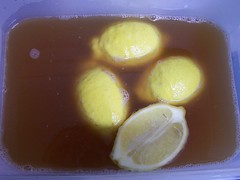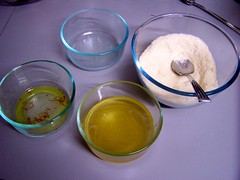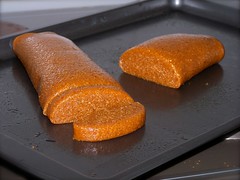I've been making a lot of home-brew wines in preparation for festival. Over the next indefinite-time-period I'll put them all up here as tutorials. To start with, though, here is the one I put on just this weekend.
I've been making home-brew wines for quite some time now, but my speciality is in meads - which are wines made from honey instead of grapes. So I quite like to try new mead recipes.
This one piqued my interest because it not only has "lemmons", but rosemary and ginger and a little spice - so it looks set to become quite a tasty brew. It's also made with a ratio of honey-water that puts it fairly within my preferred sweetness-range.
Recipe
The recipe comes originally from the "Complete Receipt Book of Ladie Elynor Fettiplace", but I have the redaction from Compleat Anachronist #120.
What I did
Ingredients for ~1 gallon batch:
- 1.7 kg honey
- water as needed
- 2 lemons
- 2 lumps of ginger
- 4 cloves
- 2 blades of mace
- 1 stick of fresh rosemary
- Ale yeast
I guesstimated the amounts for all these based on the ratios in the recipe, and my own personal experience and taste.
Equipment:
A heavy-bottomed-pot - it will need to be about a gallon and a bit in size.
A heat-resistant spoon
A few bowls
A primary-fermentation container of some kind. It must be big enough to hold a bit over a gallon of liquid and have a lid that can be closed almost-completely. I use a giant tupperware container and close it up except for one corner.
A "proper" fermentation vessel - eg a 1 gallon carboy and fitted airlock. You can get this at your local brewing shop
Step 1: "take... water and honey... and set them on ye fyre"
Put the honey into the pot. Add about 3 litres of water and stir them well together. It'll look quite cloudy.
Turn the heat onto medium and let it begin to heat up.
Set a timer for 45minutes, or just mark the time on the clock and keep an eye on it.
Meanwhile...
Step 2: "take... six penniworth of cloves & mace, one race of ginger and as much of rosemary"
Prep your spices. Take your ginger and slice it reasonably thinly. Put aside the cloves and mace, and rinse the rosemary.
You might as well cut your lemons in two while you're at it.
You should also start your yeast now by putting into a warm cup of water.
Meanwhile, back at the farm..
Step 3: "...keep them continually skimming"
By now, the honey-water will be boiling. Keep it to a simmer, and skim the scum that riseth - tipping it out into a bowl.
Step 4: "then add [the spices] and boyle them one quarter of an hour longer"
Once you've boiled and skimmed for 45min, drop the spices and ginger into the pot and let it boil for another quarter of an hour.
Step 5: "take [the lemmons] and put them into a vessel ... take the liquor boyling from the fyre & pour it into the vessel"
Your primary fermenter is likely plastic, so it'd be a bad idea to follow the directions literally and pour the hot water into it. Instead, drop the lemons into your pot, put a lid on it and allow it to stand somewhere to cool down.
Step 6: "put them into a vessel of fit bigness... when the liquor is almost cold... [add] good yest"
Hopefully your yeast has started frothing now. When the liquor is blood-warm, pour it into your fermenting vessel (lemons and all) and mix in your yeast.
Step 7: "when it hath done working, stop it up"
Now just leave it to go for a while. What the instructions mean here is that when it has done with the really super-frothy stage - you should transfer the liquid to your main carboy (without the lemons), and let it continue to ferment.
It's done when it's clear, and the recipe suggests you bottle it in sparkling-wine glasses with a small amount of sugar in each.
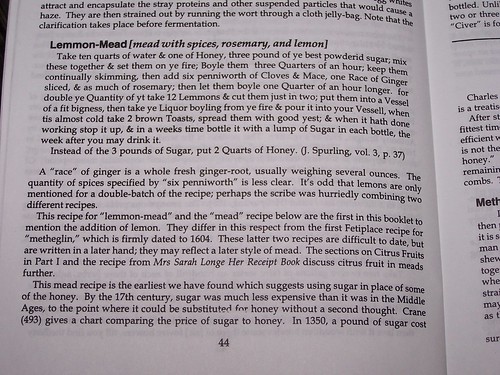
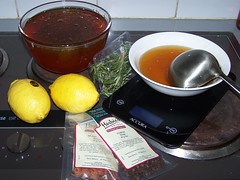
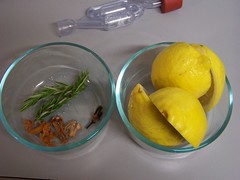
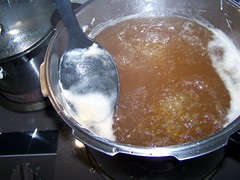
!["then add [the spices] and boyle them one quarter of an hour longer"](http://farm9.staticflickr.com/8512/8501968051_22fbe76195_m.jpg)
!["take [lemmons] and put them in a vessel ... take the liquor boyling...& pour it into the vessel"](http://farm9.staticflickr.com/8230/8501968267_e3de0a73db_m.jpg)
